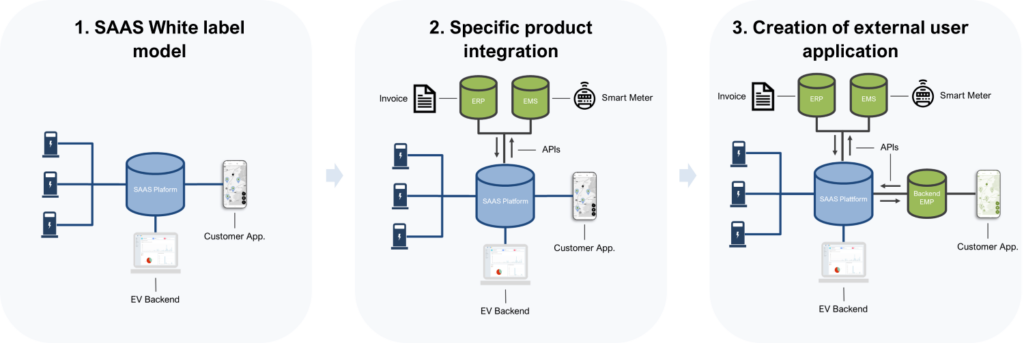All customers providing commercial EV charging services utilize a platform known as the back office. This platform serves as the central hub for operating charging stations, handling tasks such as support, authorization, billing, and energy management. The majority of market players opt for one of three approaches: developing a proprietary platform in-house, purchasing an existing platform from the market, or utilizing a Software as a Service (SAAS) platform. Each of these approaches comes with its own set of strengths and weaknesses but what is the best approach?
EV charging backend growing market requirements
The era of relying on an OCPP driver providing CDRs (charging data records), basic pricing plans with an operational console along with an app for initiating transactions, has passed. Today, a competitive EV charging backend is required to provide complex pricing mechanisms, accommodate various tiers of customers (Charging station operator, Site owner, locations…), and manage billing processes involving the integration of diverse payment gateways (e.g. Stripe, Payter, TRX, among others). Next to that, we have to integrate energy management protocols such as OSCP or OpenADR, assimilate different eRoaming protocols (such as OICP, OCPI) and hubs (e.g. Hubject, Gireve), and ultimately merge all of this seamlessly into a company’s operational environment (e.g. ERP integration). This requires knowledge and a state-of-the-art EV platform.
EV charging backend market models
- House-made development: This entails the necessity of recruiting or establishing a comprehensive IT and product team to fabricate a competitively viable platform.
- Purchasing an existing market solution: These pre-constructed solutions are retailed by companies specializing in commercial EV Charging backends, often offering room for certain customizations.
- SAAS solution: This involves acquiring a fully prepared and hosted market-ready backend and application through a licensed arrangement, typically based on charging points with system integrations facilitated by APIs.
Make, buy, or lease an EV charging software? Let’s compare!
Here is a short estimated comparison for 1’000 to 10’000 charging points with development costs that includes all charges for a complete charging service setup: (Analysis, Development, testing, White labeling, configuration…). The yearly management costs include hosting (server), service support, and market adaptations (new functionalities).
| Model | Development costs ($) | Yearly Management costs ($) | Strengths & Weaknesses |
| House-made development | 1’000’000 to 2’000’000 | 250’000 to 750’000 | + Full flexibility + IP ownership – Requires expertise and analysis (Consultancy, product definition…) – Expensive to develop and manage |
| Buy an existing development | 250’000 to 1’000’000 | 50’000 to 500’000 | + Faster to market with existing frameworks + Proven technology – Low differentiation based on “copy” of existing backends – Expensive maintenance and market adaptations |
| SAAS solution | 5’000 to 30’000 | 30’000 to 300,000 | + Fastest model to market + Price competitiveness + Constant market adaptation – Less flexibility |
The optimal approach depends on your company’s structure, strategy, and timeline for achieving your objectives. Based on this analysis, it appears that the most suitable model would be to begin by utilizing a competitive SAAS solution until you have reached a certain number of charging stations (e.g., 10,000). At that point, it could become financially viable to develop your own platform. However, this decision goes beyond a mere ‘make or buy’ cost analysis. Establishing your own platform would necessitate assembling a comprehensive team of market experts, analysts, and developers, solely to create a standard version. This expertise is readily available with a SAAS solution, and additionally, you gain the flexibility to customize your platform by integrating key systems (e.g. ERP for invoicing, ticketing system, CRM…) with APIs.
What if you could customize and adapt your model progressively?
It’s evident that every emerging EV charging business undergoes a learning curve. By commencing with a SAAS solution, you can create an attractive product, pricing, and distribution model, and subsequently refine the approach on a step-by-step basis by integrating key applications. This is possible through a modular and evolutive platform such as Saascharge with its API catalog.

At Saascharge, we have noticed that around 30% of customers (including CPOs or EMPs) tend to start by gradually integrating essential business applications. Then, they explore the possibility of developing more significant Smartphone Apps or other user-facing applications.
The benefit to invest and develop in what truly matters
The foundation of a great EV charging solution lies in delivering reliable and cost-attractive charging services. There are core service elements that you can hardly differentiate from other EV charging software. It’s all about specifics! For example, integrating with an external Energy Management System (EMS) for load management or linking with an ERP to automate invoicing for fleets, rather than relying on standard ‘credit cards’ payments. This holds greater significance than attempting to replicate existing features. You can also build specialized business applications for hotels, Fleets, Real estate management or Retailers…
Start Your EV Charging Journey with a Competitive SAAS Model and Evolve through Selective API System Integration
Despite weighing the pros and cons of various models, a backend inherently offers a range of shared functionalities. Initiating your journey today using a competitive SAAS model with API integration is a pragmatic approach to adapt your model as you grow (e.g. more EV Drivers, charging points…). This is an opportunity to create a unique EV charging product built upon your proprietary applications! Make or buy an EV charging platform? Don’t compromise, let’s get the best of both!
